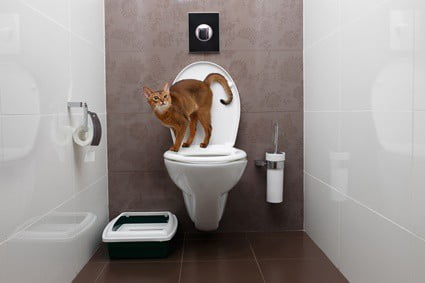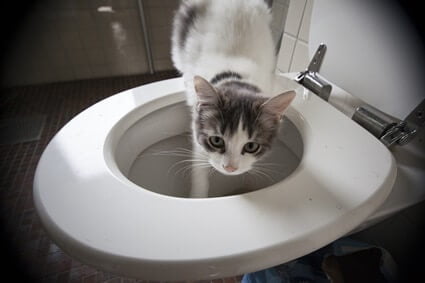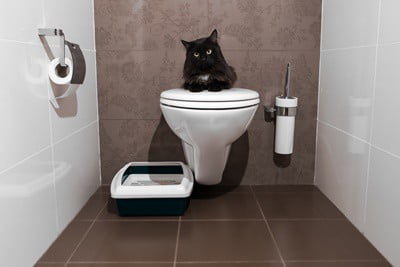Cats have all manner of inexplicable habits. A cat drinking from the toilet bowl is something that should always be discouraged. Aside from the obvious hygiene concerns, your cat could be ingesting toxic cleaning products.
Toilet water is an appealing form of hydration for cats. Regular flushing creates oxygenation, freshening up the water supply. The porcelain bowl will keep the water cool., and cats enjoy drinking moving water.
Cats are naturally curious about bathrooms as this is one of the rooms that you usually deny access. This room also contains a toilet roll, which cats love shredding for entertainment purposes. You’ll need to take stem your cat’s desire to drink from the toilet due to the presence of urine, feces, and bleach.
Why Does My Cat Drink Toilet Water?
If your cat drinks from the toilet bowl, you will likely feel a little confused by this behavior. After all, you provide your cat with fresh, clean water every day. Why would a cat want to drink dirty water?
While this habit seems disgusting to you, cats consider drinking from the toilet bowl perfectly natural. This does not change the fact that it’s dangerous, but it’s surprisingly common. Here’s why cats drink from the toilet:
Convenient Location
If your cat is in the bathroom and wants a drink, it may look to the toilet for hydration. It has easy access to a large water supply, so why seek out a bowl of warm water? A cat may enter your bathroom because it’s:
- Looking for toilet paper to play with
- Litter tray is in the bathroom
- Interested in what’s behind the closed door
- Tiled floors and porcelain baths and sinks are cooling on a hot day
If your cat discovers that it can drink from the toilet, it may be reluctant to stop doing so.

More Flavorful
Toilet water tastes great to cats, especially if it has been recently flushed. In doing so, the water will be refreshed and oxygenated. That can be more appealing than warm, stagnant tap water in a bowl.
Also, many cats are fussy about water as they can smell the chlorine found in tap water. To a cat, it’s a strange aroma that should not be there. The cat will seek what it considers a safer, cleaner water source.
The water in a toilet bowl is kept cool by the surrounding porcelain. Time it right, and the cat will enjoy ice-cool water. This appeals to a cat’s wild instincts, mirroring the chilled water that’s found in a running stream.
You’d think that your cats would smell the cleaning products and steer clear of toilet water, but that’s not the case because cats are curious creatures. The Journal of Medical Toxicology stated that household chemicals were responsible for 15.5% of 248 veterinary cases over a 3-year period.
If you catch your cat drinking from the toilet, be mindful of any signs of toxicity. These include wide staring eyes, vomiting and diarrhea, restlessness, and trouble breathing. If so, take your cat to the vet as a matter of urgency.
Moving Water
Cats are smarter than most people realize, and they are born imitators. If your cat sees you flush the toilet, it may even learn how to flush the loo itself.
Some cats will flush the toilet and then lap up the water as it refreshes. This appeals to multiple feline senses. The water is moving and is at its freshest. In theory, this is the most hygienic way for a cat to drink.
Appealing Scents
Cats may be drawn to toilet water by the aromas in the bathroom. This room is likely where you keep your favored perfumes and colognes. While cats detect humans by skin scent, they will recognize these smells, too. Your cat may assume that it’ll be able to find you by entering this room.
Perhaps your cat is attracted by the smell of soap or cleaning products. Many bleaches and similar products utilize citrus scents. Usually, this will keep cats away as they loathe the smell of lemon and lime, but all cats are different. Some cats actually enjoy the smell of citrus, even if they are in the minority.
If you keep a laundry hamper in the bathroom, this will attract cats. Felines draw comfort from clothing worn by their owners. Cats may choose to nap on such items. When it wakes up thirsty, toilet water is readily available to drink.
The absence of scent in the water may be appealing to cats. If water is too close to food or litter, it may be deemed contaminated. You will not feed your cat in the bathroom, so the water smells much fresher.
Ease of Access
Depending on how high the water flows in your toilet, your cat finds drinking from the toilet more comfortable. It may find it easier to lap from the toilet bowl than to crouch and drink from its own bowl due to back, leg, or neck issues.
Your cat may also seek toilet water due to a hidden source of pain. If your cat has dental issues, it may blame its water bowl for the discomfort. It’s also possible that your cat is allergic to its plastic water bowl. This is very common.
Consider the impact of whisker fatigue on cats. Cats’ whiskers receive lots of information from air vibrations. If the whiskers then rub against a water bowl, they’ll eventually grow sore. The Journal of Feline Medicine and Surgery explains how most cats prefer eating and drinking from whisker-friendly bowls.
Entertainment And Fun
Cats may drink from the toilet for fun. It may have been unraveling a toilet roll and then lapped at the toilet water. If your cat enjoyed this experience, it won’t be shy about repeating it in the future.
As discussed, cats are fascinated by the swirling of toilet water. If the cat watches this enough, curiosity will inevitably take over. Your cat may start to wonder what will happen if it laps at this intriguing whirlpool.
Your cat may also be drinking from the toilet because it is feeling bored. Some cats engage in behaviors that they know are inappropriate to gain attention. Your cat may be attempting to get a reaction from you.
How To Stop A Cat Drinking Out of The Toilet
There is no denying that cats should not drink from a toilet bowl. Just because your cat enjoys doing so doesn’t make it safe or acceptable. Cats are governed by survival instincts but may still develop a range of risky habits.
The main danger of a cat drinking from the toilet bowl is cleaning chemicals. In theory, the water is fresh. In reality, you may have placed bleach or other products down the toilet to kill germs and bacteria. If you haven’t flushed the toilet properly, it may contain urine and feces. Even flushing the loo won’t remove all traces of poop and pee.
There is also the risk of a cat falling into the toilet. The cat is unlikely to drown, but it will be soaked to the bone. This can reduce a cat’s temperature sharply. If you don’t discover the cat quickly, hyperthermia becomes a risk. With this in mind, keep your cat away from the toilet. Here’s how:
Restrict Access To The Toilet Bowl
Keep the bathroom door closed and shut the toilet lid. Unless your cat’s litter tray is in the bathroom due to space issues, it should not need access to this room. Human bathrooms are filled with feline hazards, and toilets are just one of them. If necessary, get a clip to keep the toilet shut as cats are smart enough to learn how to lift the lid.
Scent-Based Deterrents
Air freshener scents and essential oils may keep your cat out of the bathroom. Scents that most cats dislike include:
- Cedarwood
- Eucalyptus
- Pine
- Citrus
- Geranium
- Mint
- Cinnamon
You could also apply unwelcoming material to the toilet or the surrounding area. Cats loathe sticky substances beneath the paws. Apply some double-sided tape to where the cat gains access to the toilet.

Alternative Water Sources
If your cat hates tap water, it may drink from the toilet bowl. Deal with this by providing a different water source as the smell of chlorine may be too strong for your cat’s nose. Your cat may like drinking filtered or bottled spring water.
If your cat refuses to drink water, consider getting it a water fountain. This offers all the fun of a toilet bowl and none of the risk. A water fountain will produce a constant cascade of fresh, cool water.
Change Water Bowls
Check whether your cat has a problem with its water bowl by moving it to a different location. If the water is too close to food or litter, your cat will show no interest and attempt to hydrate from alternative sources.
If the cat is still disinterested in drinking, it may have whisker fatigue. If so, get a wider bowl, and ensure that your cat can drink freely without its whiskers touching the sides of the vessel. In the short term, you can use a deep saucer. If your cat is still reluctant to drink, get a porcelain water bowl as this will replicate the cool water of a toilet bowl.
Cats drinking from the toilet is a common behavior, but it should be discouraged. If you catch your cat attempting to quench thirst this way, you need to put a stop to it immediately. There are considerably safer ways for your cat to stay hydrated. Until you’ve introduced a solution, avoid the use of any bleach and other toxic chemicals.

